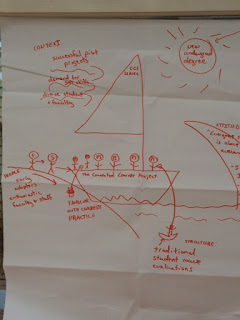A few years ago, I started noticing that some of my esteemed
colleagues in the HCI research community (such as Scott Klemmer, also Andy Ko, and others) were
talking about and publishing on their work in HCI/CS education. This was really
exciting and surprising and I immediately thought: “If they can do it, why
can’t I? I’m doing interesting things with CS education, too!” As Derek Sivers
says in his TED talk: “It only takes one follower to turn a lone nut into a
leader”. (Not really calling you a nut, Scott!) The point is that it can feel
much less risky to try something when you have well-respected colleagues who
are also doing that thing.
One of the barriers to adoption of curricular innovation for
computing faculty members is the perception that innovating, adapting best
teaching practices and conducting research into teaching is not valued by
research peers. If a faculty member thinks that external reference letter
writers are unlikely to value such contributions when they are up for tenure or
promotion, the effects are actually two-fold: they may not engage in such work,
or if they do, they may be unlikely to discuss it with their peers at their
core research conferences and meetings.
It seems relatively uncommon for research-track CS faculty
to discuss their teaching at conferences and research meetings (no, I’m not
saying it never happens, but it is rarely the focus, except at CS education conferences
like SIGCSE and ICER). So, while we are likely aware of our colleagues’
research projects, we may not realize that our colleagues are experimenting
with innovative teaching methods, trying out new learning technologies or
adapting some best practices related to active learning. Because we don’t talk
about it, we may think it’s not happening and this can lead to us not wanting
to talk about our own innovations. We think our colleagues only value core
research, so that is what we focus our own discussions on.
This ‘teaching research taboo’ brings up some interesting
questions:
1.
Would some faculty members be more willing to
innovate, adapt best practices and try new teaching methodologies if they knew
their research peers were also doing this?
2.
If the answer to #1 is yes, how can we encourage
researchers to take the time to discuss their teaching (and teaching research) when
at conferences and meetings?
3.
Would it be helpful to identify top researchers
in particular CS areas and invite those researchers to visit, specifically to
talk about their teaching innovations? Could this make a difference in areas
where faculty are not buying in to active learning and other innovations?
I don’t know the answers to these questions, but I think
there’s something here. I say let’s figure out how to ditch the ‘teaching
research taboo’. Maybe next time you are at a conference, you should ask some
of your most respected colleagues if they do any teaching innovation. You might
be surprised by what you find out.

